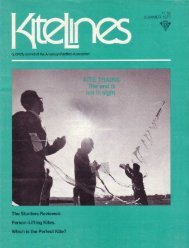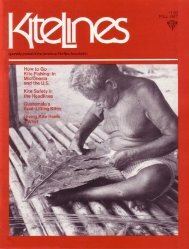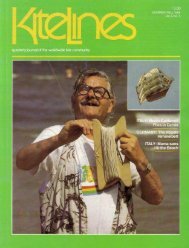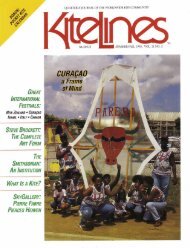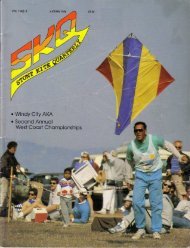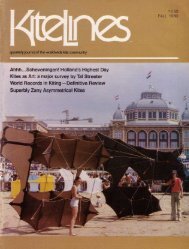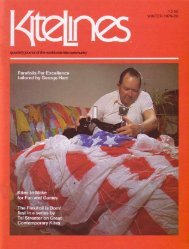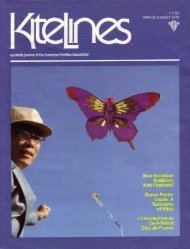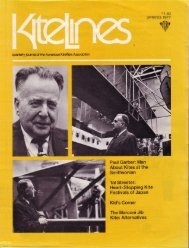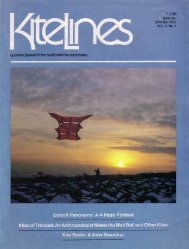Kite Lines - Vol.2 No. 4 - KiteLife
Kite Lines - Vol.2 No. 4 - KiteLife
Kite Lines - Vol.2 No. 4 - KiteLife
- No tags were found...
Create successful ePaper yourself
Turn your PDF publications into a flip-book with our unique Google optimized e-Paper software.
The Bedsheet O'dakoBy A . Pete lanuzziIn an effort to make a big display withoutlavish investment of time or cash, sixMaryland <strong>Kite</strong> Society members eachmade one or more large kites in theJapanese style using U .S .-available materials-kingsize sheets and pine sticks . Wesoon called this kite the Bedsheet O'dako .The original plan was to join the kitesin train for a man-lift, but we found thatthese kites, with all their bridles, were difficultto link together . All the same, theymade a great show flown individually .I worked out the plans and ripped allthe sticks from pine for the big endeavor .The sheets, on sale, were in the garishmode, but made fairly striking kite covers .VARIATIONSThe Bedsheet O'dako allows for considerablevariation in dimensions and materials .For example, any size of sheet may beused . Also, an artist might favor use ofsolid color cloth sewn in sections or simplywhite sheets, canvas-like, to paint .MATERIALS• Sheet for cover and extra fabric for thetwo tails-about 4 to 6 inches wide andabout 30 to 40 feet long . Tails take abouta quarter of a sheet .• Sticks of clear straight-grain pine orspruce : 5 longerons, 7,,z x '/.I section andof a length to fit your cover (about 10feet) ; 5 ribs, 3 /+e x 3 '411 section, length to fitcover ; and 2 diagonals, 1,4 x 3/41 1 . <strong>No</strong>te thatthe shape of the kite is determined by thebridling and not by the sticks, which areflexible, serving mainly to tauten the cover .• Line for bridles : about 20-lb . test isadequate because there are so many ofthem . Cotton or polyester is recommended,not monofilament or anything elastic .• Flying line : at least 100-lb . test .Clothesline is not a bad idea-it's strongerthan you need but it's good to hold onto .INSTRUCTIONS1 . Start by drawing the design on theback of the sheet (pencil works fine) .Find the center by folding . Measure in 6'/4 iifrom the selvage edges and 5 1 1 up from thebottom . Then divide into four equal spaces.2 . Hem the edges of the sheet, using tworows of stitches for strength . On the topand bottom, leave the original hem stitchingand add one extra row .3 . Remove stitches in pocket areas, thenstitch 22 pockets (as shown in sketches) .Use a stick (about 3/4 x 1,4 x 611) to checkpocket size . It should fit easy .4 . At the intersections of all ribs andlongerons, mark the cover for four bridleholes, as shown in detail drawing C .5 . Attach 21 bridles, each about 16 1 long,at all marked intersections, without sticksin place . A large, upholstery-type needleis good for this . Use a bowline knot ifyou know it . Any knot that will not slipwill do . The loop should be about 3 11from kite cover to knot . For the five locationsat the top of the kite, tie bridles inthe criss-cross format shown in the sketch .6. Transport the kite in stickless and taillessform and assemble it at the flying site,passing the sticks through the cord loops .7 . Bow the kite on the back, using 20-lb .test or stronger line, to curve at least 611deep at the top and about 8?? deep at thebottom, but the rib one up from the bottomshould be 10 11 deep (or deeper forstronger winds) .8 . Adjust the bridles in a wind-shelteredarea . It is easiest to place the kite upsidedown at an angle that corresponds withthe normal flying angle (about 30 degrees) .With the kite in this position, leaningbackward, it's convenient to adjust thebridles . Adjust them to a uniform tension,to pull evenly on the kite when it is in itsproper, bowed shape .I like to handle the lines in horizontallayers, getting each row uniform, tyingthose lines together, then doing the nextrow . After all layers are tied, I bunchthem together and trim them so they areabout the same length . Then I tie all ofthem together in one big slip knot .FLYINGTake your flying line and tiea big loop on the end, then alark's head knot around all thebridles just above the slip knot .Attach two tails, using short pieces ofstring, to each side of the kite . By now, ifyou didn't bring any, assistants shouldhave materialized like magic . Have themhold the kite up for launch . Walk outplenty of line (at least 150 feet) . Put onyour gloves and fly!For transport, leave only the five ribsin the kite and roll it up in a neat package .To keep the bridle lines from tanglingafter flight, they can be braided togetherwith a chain knot (see sketch) before youtake the kite apart . A.P .I ./V .G .



